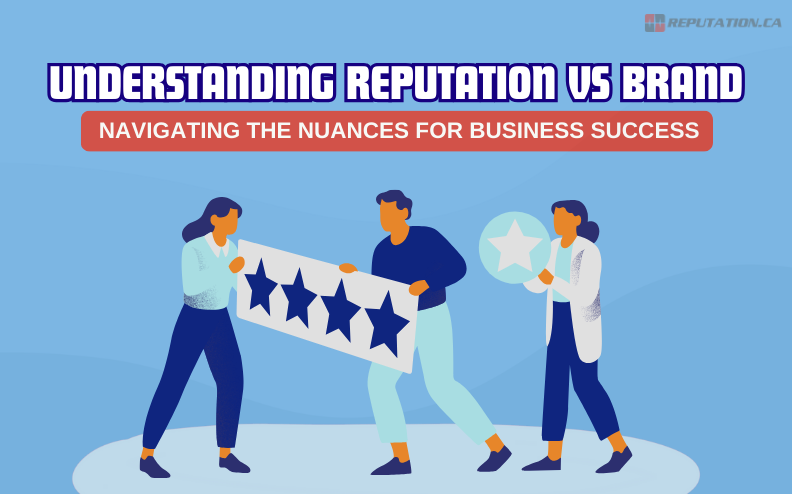Key Takeaways
- A brand represents the controlled identity and promise of a company, crafted through marketing and branding efforts, whereas reputation is shaped by the public’s collective opinion, influenced by customer experiences, social responsibility, and various external factors.
- Both brand and reputation significantly affect each other; a well-established brand can foster a positive reputation, while reputation management involves actively engaging with public feedback and perceptions to maintain or enhance a brand’s image.
- Building and managing a strong brand and positive reputation requires consistent brand messaging, exceptional customer service, and the use of reputation management tools to monitor and address the public’s perception effectively.
Defining Brand and Reputation

A brand is more than a catchy logo or a catchy slogan—it is a company’s controlled perception. It’s the image that a company meticulously crafts to define its identity in the eyes of its target audience. It’s the promise that the company makes to its customers, communicated through marketing campaigns and social media posts. It’s the story that the company tells about its values, aspirations, and commitments.
On the other hand, reputation is the public’s perception of the company. It is the collective opinion formed by everyone who interacts with the company, from customers and employees to investors and journalists. Unlike a brand, a company can’t fully control its reputation. It is influenced by customer experiences, online reviews, and word-of-mouth. A single negative incident can lead to a negative reputation, while consistently meeting brand promises can help establish a favorable reputation.
Brand: Controlled Perception
Building a robust brand begins by comprehending the company’s values and developing a compelling brand identity that resonates with the target audience. The company then needs to consistently deliver on its brand promises, providing high-quality products and exceptional customer service. Social media platforms can be used to communicate the brand’s story and engage with customers. Consistency in brand messaging is crucial for building trust and loyalty, distinguishing the brand from competitors, and delivering a uniform brand experience.
A strong brand has the potential to enhance customer loyalty and trust, set the business apart from its competitors, and ultimately drive higher sales and revenue. Companies like Coca-Cola, Starbucks, and Tesla have built strong brand reputations through effective branding strategies, yielding significant business success.
Reputation: Public Perception
Although a company can control its brand, external factors like customer experiences and public opinion largely influence its reputation. Key factors that can significantly impact a company’s reputation include:
- The quality of its products or services
- The level of customer service it provides
- Its social responsibility initiatives
- Its marketing strategies
For instance, a company that is perceived to be socially responsible or that consistently delivers exceptional customer service is likely to have a positive reputation.
Nonetheless, managing a company’s reputation poses a complex challenge. It involves actively engaging with customers and stakeholders, prioritizing positive customer service experiences, and consistently taking actions to enhance public perception. A company’s reputation can be damaged by negative reviews, product quality issues, or customer service failures. Therefore, it is essential for companies to actively monitor their reputation and promptly address any negative feedback.
The Interplay Between Brand and Reputation
Brand and reputation are akin to the two faces of a coin. They influence each other profoundly and play a key role in shaping a company’s success. A strong brand can contribute to a positive reputation by fostering trust and loyalty among customers. Conversely, a negative reputation can significantly damage a brand that a company has invested years, or even centuries, in building. Understanding the aspects that brand reputation involve is crucial for maintaining a strong brand.
The psychological connection between a brand and its reputation is rooted in the strong identity that effective brands have, which consumers can relate to. This connection is driven by a deep understanding of psychology and brand loyalty. Consumers’ feelings and identities significantly influence the brands they choose, and brand psychology can profoundly impact consumers’ perception of a brand, including its values, reputation, and the emotions it evokes in customers.
How Brand Affects Reputation
A robust brand:
- Sets a company apart from its competitors
- Cultivates trust and loyalty among its customers
- Consistently delivers on its brand promises
- Maintains a consistent brand image across all touchpoints
- Meets or exceeds customers’ expectations consistently
- Enjoys a positive reputation
- Customers are more likely to trust and stay loyal to companies that deliver on their promises and provide high-quality products or services.
Maintaining a consistent brand message is crucial for building trust, establishing credibility, and creating customer loyalty. It allows the brand to evolve and expand while providing superior customer service, ultimately leading to increased market share and better recognition. Companies like Coca-Cola, Starbucks, Tesla, Arby’s, Nike, and Google have enhanced their reputation through effective branding strategies.
How Reputation Affects Brand
Even though a robust brand can bolster a company’s reputation, the reverse is also factual. A company’s reputation can significantly impact its brand image. A positive reputation can elevate a brand by fostering trust and attracting new customers. Customers are more likely to choose a brand that they perceive as trustworthy and reliable. Conversely, a negative reputation can damage a brand’s image, diminish trust, and result in a decline in customer confidence.
Instances where a positive reputation has notably improved a brand’s image include fostering trust in customers, thereby increasing the likelihood of them choosing the brand, and elevating the perceived value of the brand, consequently enhancing brand equity. On the flip side, a negative brand reputation has the potential to damage a company’s credibility, diminish trust and customer loyalty, and could result in a decline in customer confidence.
Building a Strong Brand and Positive Reputation

For any business, a robust brand and a positive reputation are integral assets. They can drive customer loyalty, attract new customers, and differentiate a company from its competitors. However, building a strong brand and a positive reputation requires a brand reputation strategy that involves understanding the target audience, delivering consistent messaging, and providing exceptional customer service.
A company’s brand and reputation are dynamic, necessitating careful management and nurturing over time. This involves brand reputation management through:
- Promoting the brand through marketing campaigns and social media
- Actively managing the company’s reputation by monitoring customer feedback
- Responding to online reviews
- Addressing any negative perceptions
Crafting a Compelling Brand Identity
A compelling brand identity is more than just a logo or a catchy slogan—it’s the story that a company tells about itself. It’s the company’s mission, vision, and values. It’s the promise that the company makes to its customers and the experience that it delivers. And it’s the emotional connection that the company creates with its customers.
Creating a compelling brand identity involves:
- Defining the company’s story, purpose, and values
- Connecting with the target audience on an emotional level
- Maintaining a consistent brand image across all touchpoints, from the company’s website and social media profiles to its marketing campaigns and customer service
The goal is to create a brand identity that resonates with the target audience and builds trust and loyalty.
Reputation Management Techniques

Managing a company’s reputation involves actively monitoring and addressing customer feedback, reviews, and comments across different platforms. It involves being proactive in responding to negative feedback and leveraging positive trends to enhance the company’s reputation. A company’s reputation can be managed by using reputation management tools, staying active on social media, and maintaining a positive online presence.
Effective reputation management involves not only responding to negative feedback but also promoting positive feedback. It involves being transparent and accountable, and showing that the company values its customers and their feedback. By doing so, a company can build trust and loyalty, enhance its reputation, and drive business success.
Measuring and Monitoring Brand Reputation

For any business, it’s critical to measure and monitor brand reputation. It allows a company to understand how it is perceived by its customers and the public, and to identify any potential issues or opportunities. Key metrics for assessing brand reputation include customer satisfaction levels, the prevalence and sentiment of online reviews, and general brand awareness among consumers.
There are various tools and resources available for measuring and monitoring brand reputation. These include Google Alerts, which provides updates on brand mentions, and social listening software, which allows companies to monitor online conversations and mentions of their brand. Using these tools, a company can keep track of its reputation and take proactive steps to enhance it.
Key Metrics for Assessing Brand Reputation
Several key metrics can yield valuable insights when assessing brand reputation. One of the most crucial is the Net Promoter Score (NPS), which gauges customer loyalty by measuring their likelihood to recommend a brand to others. High NPS scores indicate that customers are satisfied and likely to recommend the company, signaling a favorable perception and a robust brand image.
Other key metrics include:
- Customer satisfaction rates: provide insights into how well a company is meeting its customers’ needs
- Social media engagement: shows how effectively a company is interacting with its customers
- Online reviews: provide a wealth of information about a company’s reputation, from the quality of its products and services to the effectiveness of its customer service.
Tools and Resources for Reputation Management
A variety of tools and resources exist for the management and monitoring of brand reputation. These include:
- Google Alerts, which provides updates on brand mentions
- Hootsuite, which allows companies to manage their social media accounts
- SEMrush, which provides insights into a company’s online visibility and performance.
Other tools include:
- Trustpilot, which allows customers to leave reviews of businesses
- Reputology, which helps companies monitor and manage online reviews
- Mentionlytics, which provides insights into a company’s social media presence
Using these tools, companies can proactively monitor their brand reputation, identify potential issues, and take steps to address them.
Real-World Examples of Brand and Reputation Successes and Failures

While grasping the concepts of brand and reputation is important, observing their real-world application fosters an enhanced understanding. Successful companies like:
- Nike
- JetBlue
- Whole Foods
- Zappos
Numerous studies have shown how a strong brand and a strong brand identity, along with a good brand reputation, can drive business success, while a poor brand reputation can hinder it.
On the other hand, companies like:
- EasyJet
- Tesla
- H&M
- Dolce & Gabbana
have faced significant reputation challenges. These examples highlight the importance of reputation management and the potential consequences of reputation mishaps.
Success Stories
Companies like Apple, Nike, and Google are often cited as having strong brands and positive reputations. Here are some reasons why:
- Apple has built a strong brand through its commitment to innovation, design, customer experience, and simplicity.
- Nike has maintained a strong brand reputation through its commitment to high-quality products and effective marketing strategies.
- Google’s reputation has been built on its commitment to providing exceptional user experience and being recognized as a trustworthy source of information.
These companies have shown that a strong brand and a positive reputation can significantly enhance a company’s success. They have shown how a company can connect with its target audience, deliver on its brand promises, and build trust and loyalty among its customers.
Lessons from Reputation Mishaps
Even the most sizable and successful companies can encounter reputation blunders, leading to a damaged brand reputation. For example:
- United Airlines experienced a 500 percent increase in negative perceptions after a passenger incident
- Wells Fargo’s brand image suffered greatly due to the ‘fake accounts’ scandal
- Volkswagen faced a notable decrease in their brand value after the emissions scandal.
These examples highlight the importance of reputation management and the potential consequences of reputation mishaps. They show how a negative reputation can damage a company’s brand image, diminish trust, and result in a decline in customer confidence. They also show how companies can recover from reputation mishaps by taking responsibility, aligning stakeholders, formulating a proactive plan, and implementing measures to restore trust and integrity.
Question: What is the difference between a brand and reputation?
Answer: A brand is a company’s controlled perception, crafted by marketing campaigns and branding efforts, while a reputation is the public’s perception, influenced by customer experiences and public opinion.
Question: Why is reputation management important?
Answer: Reputation management is crucial as it enables companies to identify and mitigate reputational risk, while also exploring potential opportunities to enhance their market position.
Question: What are some examples of companies with strong brands and positive reputations?
Answer: Apple, Nike, and Google are examples of companies that have effectively managed their brands and reputations.
Question: What are some lessons from reputation mishaps?
Answer: Companies like United Airlines, Wells Fargo, and Volkswagen have faced significant reputation challenges. These examples highlight the importance of reputation management and the potential consequences of reputation mishaps.
Question: What tools can be used for reputation management?
Answer: Tools like Google Alerts, Hootsuite, and SEMrush can be used for managing and monitoring brand reputation.
Summary
In conclusion, brand and reputation are two interconnected concepts that can significantly impact a company’s success. A strong brand can foster trust and loyalty among customers, while a positive reputation can enhance a company’s brand image. Companies need to proactively manage their brand and reputation, monitoring customer feedback, responding to online reviews, and maintaining a positive online presence. With the right strategies and tools, companies can build a strong brand and a positive reputation, driving customer loyalty and business success.












